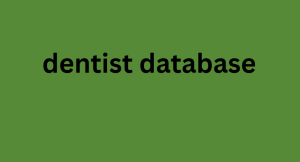In today’s fast-paced marketing world, efficiency is crucial. Businesses are constantly seeking ways to maximize results while minimizing costs and effort. Special databases offer an innovative solution, enabling marketers to target the right audience, optimize campaigns, and achieve significant results with fewer resources.
By leveraging these tailored data collections, marketers can streamline processes, enhance personalization, and increase Achieve More with—all while reducing waste.
What Are Special Databases in Marketing?
Special databases are customized collections of data designed to serve specific marketing purposes. Unlike generic databases, dentist database these are fine-tuned to address unique needs, such as industry targeting, audience segmentation, Achieve More withor behavioral tracking. Examples of special databases include:
- CRM Databases: Track customer interactions and store personal details.
- Demographic Databases: Provide data on age, gender, income, and location.
- Behavioral Databases: Monitor user activities, purchase habits, or online engagement.
These databases make it easier to identify and focus on high-potential leads, helping businesses do more with less.
Benefits of Using Special Databases in Marketing
1. Precise Audience Targeting
Special databases allow marketers to focus their efforts on the right audience segments. Instead of adopting a one-size-fits-all approach, Achieve More withyou can target customers based on specific criteria, such as:
- Demographics (age, gender, income, etc.).
- Psychographics (interests, lifestyle, or preferences).
- Behavior (purchase history or website visits).
For instance, a beauty brand can use a special database to identify customers interested in skincare products and create campaigns tailored to their needs. This precision reduces wasted efforts and ensures resources are used effectively.
2. Enhanced Personalization
Modern consumers expect personalized experiences, and special databases provide the foundation for delivering them. By analyzing customer data, Achieve More withou can craft messages and offers that resonate with individual preferences.
Examples include:
- Sending birthday discounts to loyal customers.
- Recommending products similar to a user’s past purchases.
- Offering region-specific promotions.
Personalized campaigns foster stronger , examples of landing pages by sector connections with customers, leading to higher engagement and conversion rates.
3. Cost-Effective Marketing
Traditional marketing often involves significant costs due to its broad and less targeted nature. Special databases help reduce these expenses Achieve More with by narrowing the focus to high-value prospects. With detailed data at your fingertips, you can:
- Avoid spending on uninterested audiences.
- Increase.by targeting potential customers more likely to convert.
- Optimize resources, such as time, manpower, and budget.
For example, a small business can use a geographic database to advertise only to local customers, saving money on unnecessary ad spend.
4. Streamlined Campaign Execution
Special databases integrate seamlessly with marketing automation tools, enabling streamlined execution of campaigns. aub directory Achieve More with You can automate processes such as:
- Email campaigns triggered by user behavior.
- Social media ads targeting specific audience groups.
- Follow-ups and reminders for leads.
This integration not only saves time but also ensures that campaigns are timely and relevant, maximizing their impact.
How to Leverage Special Databases for Maximum Efficiency
1. Choose the Right Database
The effectiveness of your marketing efforts depends on the quality and relevance of your database. Consider the following when selecting one:
- Does it align with your target audience?
- Is the data accurate, up-to-date, and comprehensive?
- Can it integrate with your existing tools and platforms?
For example, a B2B company might invest in an industry-specific database to target key decision-makers in specific niches.
2. Segment Your Audience
Audience segmentation is key to making the most of special databases. Divide your audience into smaller groups based on common characteristics or behaviors. This enables you to create tailored campaigns that speak directly to each segment.
For instance:
- A clothing retailer can segment customers by seasonal preferences, promoting winter wear to one group and summer attire to another.
- A software company can separate leads based on company size and offer solutions tailored to small businesses versus large enterprises.
3. Automate Your Marketing Efforts
Automation tools, when combined with special databases, Achieve More with enable businesses to do more with less effort. Examples include:
- Automated email sequences triggered by specific actions, like a customer signing up for a newsletter.
- Dynamic ad campaigns that adjust based on user behavior or demographics.
- Retargeting campaigns using data from abandoned carts or previous site visits.
Automation ensures consistent messaging and frees up time for strategic planning.
4. Measure and Optimize Results
The data from special databases doesn’t just aid campaign execution—it’s also essential for performance analysis. Use analytics tools to monitor key metrics such as:
- Click-through rates (CTR).
- Conversion rates.
- Return on investment.
Based on the results, refine your strategies to focus on what works best. For example, if one segment responds better to discount offers, Achieve More with you can allocate more resources to similar campaigns.
Overcoming Challenges with Special Databases
While special databases offer many benefits, there are challenges to consider:
- Data Quality: Outdated or incomplete data can hinder your campaigns. Regular updates and validation are essential.
- Privacy Compliance: Ensure you comply with regulations like GDPR or CCPA when handling customer information.
- Initial Costs: Building or acquiring a high-quality database may require an upfront investment.
By addressing these challenges proactively, you can fully leverage the potential of special databases.


